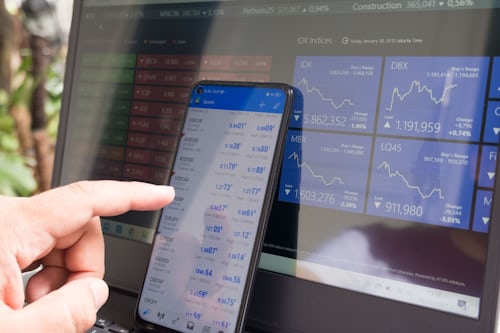To trade or invest in the DAX, you must first decide how you want to position yourself. Trading with CFDs and spread bets may be the best way to go long and short. If you intend to buy as part of a long-term strategy, you may prefer investing.
In this post, we’ll take a closer look at the main investing methods in the DAX DE40 index.
Table of Contents
What is the DAX index?
The DAX index was launched on July 1, 1988. It is calculated as the weighted average value of stock price capitalization, which is counted on only flexible stock prices. The DAX 40 Aktuell also includes dividend income from stocks expected to be reinvested in securities. Simply put, the index reflects the overall profitability of capital. This is the primary distinction between the DAX and other indices.
Ways to Invest in the DAX
Both share trading and ETFs allow you to invest in Germany’s largest companies in slightly different ways.
1. Share Dealing
The DAX fluctuates in response to the share price movements of the companies that comprise the index, such as Volkswagen, Bayer, and Deutsche Bank. You can get similar exposure to the DAX by purchasing shares in these companies.
To create a portfolio that closely tracked the DAX’s movements, you’d have to buy all 30 constituents and mirror the official index’s weighting criteria, which is a difficult task. As a result, most investors will select a few stocks for their portfolio and use ETFs to invest in the entire DAX.
2. ETFs
When you purchase a DAX ETF, you invest in a fund that tracks the index’s price. Many DAX ETFs do this by holding the index’s constituent stocks, so when you buy, you’re effectively investing in all 30 companies with a single position.
ETFs, like stocks, can be bought and sold on exchanges. As a result, you can invest in them through the same provider you use for stock trading.
3. DAX Peculiarities
The DAX index is inextricably linked to the German economy: if the country’s economic situation improves, so will the index. Previously, the index included the indicators of 30 German companies. Still, after September 2021, the index’s composition was expanded to 40 companies trading on the Frankfurt Stock Exchange: BMW, SAP, BAYER, MERCK, ADIDAS, and so on.
The list of companies included in the index needed to be fixed and changed based on company capitalization. If a company was experiencing significant losses, it was excluded from the index; conversely, if it was gaining momentum, increasing profits, and capitalization, it was included in the index. The company list is updated once a quarter. The index is calculated during the XETRA exchange’s 9 am to 5 pm CET.
What Moves the DAX Index’s Price?
The DAX has higher volatility than other major indices, making it a popular trading index. Here are a few key drivers of DAX price action:
1. Economic Releases
German businesses typically perform well when the broader economy is expanding and struggle when the economy is contracting. As a result, economic indicators can significantly impact the DAX.
2. Exchange Rates
The most valuable companies in Germany are primarily export-oriented: BMW, Volkswagen, and Bayer, for example, rely on global exports for profits. The value of their shares can be affected by the euro’s strength.
3. Earnings Reports
Positive earnings reports from constituents can drive the DAX higher, while adverse earnings reports can drive it lower. Because the index is capitalization-weighted, larger companies have a more significant impact on its level.
Ways to Trade The DAX
Cash markets and futures are the two main types of DAX CFDs and spread bets.
1. Index Futures
When you open a position in an index future, you are trading at its futures price, the price agreed upon today for delivery later. The spreads on index futures are wider than on cash indices, but the spread includes all overnight funding charges. If you intend to keep your trade open for several days, index futures offer better value.
2.Cash Indices
When you open a position in a cash index, you are trading at its spot price, which is the current level. Cash indices have lower spreads, making them popular among short-term traders. IG’s DAX spreads, for example, begin at just 1.2 points. You must pay an overnight funding charge if you hold a cash index position for more than one trading day.
DAX Trading Strategies and Tips
1.Learn Your Technical Indicators
Many traders rely on indicators to help them identify new opportunities and time their trades. So, learning how to use the RSI, moving averages, and other indicators is a good idea.
2.Use Trading Alerts
Trading alerts notify you when certain conditions on the DAX are met. You could set up a buy alert when the DAX reaches a certain level. You can receive an email, SMS, or push notification.
3. Pay Attention to Price History.
The previous price action of a market can provide clues as to where it will go next. Learning how to read DAX charts can help you spot new trends.
4. Develop a Plan
Setting out a plan before you begin trading that dictates which markets you trade, your risk-reward ratio, and other factors can effectively remove emotion from your day-to-day activity.
5. Keep An Eye on Economic Announcements.
The DAX’s price will be influenced by Germany’s, Europe’s, and global economic health. So keep an eye out for new data on inflation, GDP growth, and employment.
Bottom line
Trading the DAX index appears difficult at first glance, but it is almost identical to trading other financial instruments. It applies to all trading strategies, including Price Action, scalping, and indicator-based strategies. You can also trade it with the help of expert advisors, but only after thoroughly testing the bot on a demo account.














